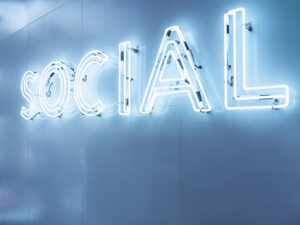What influence does social media have on people’s behavior?


Digital media are bringing people and brands closer together.
As a result, knowing what social media is, and the influence it exerts on people’s behavior, is a mandatory skill for anyone looking to thrive in the business world.
What is social media?
As the name suggests, social media is the sum of all the multilateral online connections between people around the world. This means of communication has been gaining prominence for almost two decades, strengthening its presence in everyday life.
Since Orkut shut down (there are rumors of a comeback!), several social media platforms have gained notoriety and prominence, while others have lost ground. Nowadays, Facebook, Tik Tok, Instagram, Linkedin, Twitter, and Twitch, for instance, all reach users in their specific segments.
On social media, people can communicate amongst themselves via instant messages and posts, to name a few tools. Social media platforms are diverse and can vary significantly according to their goals, which can include:
- Creating personal connections, such as friendship and dating
- Networking and career management
- Searching and sharing videos and pictures
- Advertising products
- Gaming
Regardless of their focus, these platforms have the same purpose: to bring people with similar interests together. As their presence in people’s lives grows stronger, they influence our behavior in ways which we will examine below.
What influence does social media have on people’s behavior?
The influence of digital relationship platforms extends beyond the screen, becoming a part of people’s and companies’ lives, and having a direct impact on the real world.
Neuroscience and psychology are committed to understanding this impact. Let’s look at some of the relevant aspects of social media’s influence on people’s behavior:
Immediacy
When someone is waiting for an answer on social media – either on the personal and professional level, when buying or hiring something – the quicker the better.
Companies need to keep their eyes open and monitor brand mentions and interactions with the buyer persona (fictional representation of one company’s ideal client) on digital mediums.
Empowerment
Social media is an extremely pluralized and diverse space, where users can find their peers and express their ideas and interests.
It is also a place where comments, opinions and reviews about brands – positive or not – can take on gigantic proportions and influence other users with similar interests.
Belonging
Wanting to be a part of something is an inherent drive in humans. Finding people who share one’s ideas means feeling validated. Applying strategies and connecting to your target audience’s values is one way for brands to insert themselves and “belong” to a group too.
Side Effects
According to studies, too much social media can lead to negative side effects, such as short-term memory loss due to easy access to search engines.
Another recorded issue is “nomophobia,” short for “no-mobile-phobia”. This is the fear of not having your smartphone near you, which can generate anxiety, especially among teenagers.
Studies also point to further issues such as:
- Development of a fake self-identity
- Intolerance
- Anxiety
- Depression
How understanding this influence can inform Digital Marketing
The most valuable asset of any company is the client. Knowing how their minds work means being able to serve them effectively, build loyalty and generate engagement.
Social Media in Marketing
Social media marketing represents an excellent opportunity for a brand to get closer to its consumers, putting the client at the center of its planning. There are numerous tools for this, but the main ones we can use are:
- Inbound Marketing
- Sponsored Ads
- Branding and brand positioning
- Brand humanization
- Chats
- Web analytics, and others.
Neuromarketing
Combining neuroscience and marketing, neuromarketing is a useful tool for companies looking to make a space for themselves on social media.
Applying techniques such as mental triggers, color psychology, and storytelling can improve companies’ results towards consumers on Web 3.0.
– Mental Trigger
These techniques, based on behavior patterns, include:
- Reciprocity;
- Coherence and commitment;
- Affection;
- Social Approval;
- Scarcity;
- Authority;
- Unity;
– Color psychology
Several psychology and neuroscience studies reveal how colors impact people, animals, and even plants. Messaging can vary depending on the color used. Check out some examples below:
- Red: passion, motivation, bravery
- Orange: Happiness, interaction
- Green: Health, harmony
- Blue: serenity, calm
- Yellow: optimism, inspiration
- Black: exclusivity, classiness, protection
- White: purity, honesty
– Storytelling
Storytelling allows companies to engage users and generate feelings of belonging, reciprocity, and unity.
That’s why understanding social media’s influence on people’s behavior is the first step to creating strategies for efficiently interacting with your audience.
Read more:
What influence does social media have on people’s behavior?
